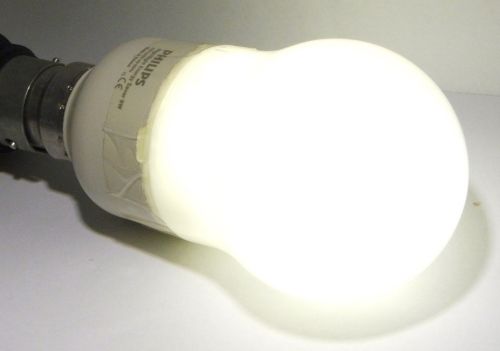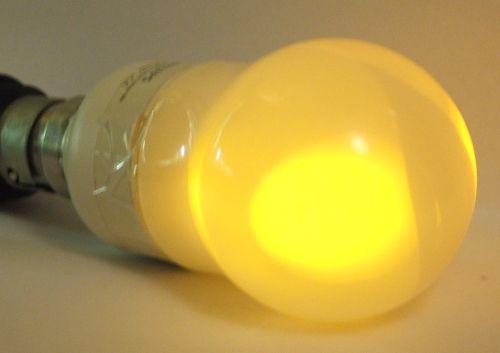
| Manufacturer: | Philips |
| Model: | 2 in 1 Nightlight |
| Application: | General Lighting and low level night time illumination |
| Wattage: | Main: 9W (10W measured). Nightlight: Not Stated (1W Measured) |
| Diameter (max): | 65mm (A65 lamp shape) |
| Length: | 130mm |
| Tube Length: | 240mm approx |
| Bulb/Tube material: | Inner: Glass - Colour 827 phosphor inner coating. Outer: Glass, soft white inner coating. |
| Colour Temperature: | Fluorescent: 2700K. LED: 1500K Approx |
| Peak output wavelength: | Fluorescent: N/A - broadband emission. LED: 580nM (estimate!) |
| Total light output: | Fluorescent: 420Lm (46.7Lm/W). LED: Not Stated. |
| Rated lifetime: | 6000 Hours |
| Cap: | B22 |
| Operating voltage: | 230-240V AC at 50-60Hz |
| Operating current: | Fluorescent: 70mA (pf=0.57). LED: 30mA (pf=0.18). |
| Warmup/restrike time: | Fluorescent: 1 minute (approx)/none. LED: None/None. Ballast preheats lamp electrodes for around 1/4 second. |
| Cost (original): | £6.99 mid 2004 from Tesco Supermarket. |
| Place of manufacture: | Poland |
| Date of manufacture: | 2004 - no date code present. |
| Lamp Status: | Cosmetically damaged, but fully working |
Precisely how I forgot about this lamp for two years I'm not sure...The word "Oops" springs to mind!
The
electronics within the modern electronically ballasted CFL can, with a
few additional components prove an astonishingly flexible bit of
technology. While we're only used to seeing CFLs being CFLs here
- in the last year or so, self-dimming ones have started to make
appearances. Dusk-to-dawn sensors and the like are also becoming
more common, but dual light sources are less common.
In this
case, we have a lamp which is trying to fill two very distinct roles.
Both that of a conventional low-wattage CFL, and taking over the role of a low-output night-light.
Some
years ago, GLS glow-lamps were popular as nightlights for children's
bedrooms or low-level nigh time lighting in hospital corridors and such
on account of their relatively low cost, very long lifetimes and (at
the time) virtually negligible power consumption. In their
original form, these lamps disappeared from all but the shelves of
collectors around 20 years ago, with plug-in nightlights using small
neon indicator lamps largely taking over their roles in the home, and
ballasts allowing fluorescent lamps to be dimmed or all but one or two
tubes in multi-lamp fixtures becoming more common in hospitals and
similar large buildings.
This appears to be the market
share that this lamp is going for - as there are, in addition to the
conventional fluorescent tube, two Aluminium indium gallium phosphide
(AlInGaP) LEDs, which give a low-level, deep amber glow from the lamp
when energised.
When the lamp is first switched on, it behaves
as any normal 9W CFL would be expected to. It's not especially
bright, but then again, you wouldn't expect it to be really, and does
seem to take a bit longer to warm up than some lamps. However, if
you then switch it off and back on again (within 3 seconds if I
remember rightly), instead of the main lamp lighting, the lamp will
glow a deep amber colour, quite unlike anything you'll ever have seen
from a CFL before. This is due to the two LEDs which are hidden
away inside the lamp, near the base of the tube. The output of
these LEDs is a slightly more yellow colour than the output of the
negative-glow neon lamps, but is of a similar level, so should serve
quite well as a nightlight. As for power usage, "very low"
springs to mind, around 1.2W. While the actual lamp output is
very similar, once it's stuffed inside a shade as the normal CFL will
be, that output is quite considerably attenuated in most cases...so the
thought occurs that Philips might have been better going for a bit
higher output to compensate for that.
The only slight concern I
have over this lamp is for the longevity of the LEDs. They are
situated close to the base of the lamp, right next to the lamp
electrodes, by far the hottest part of the lamp. LEDs do not like
getting too hot, it reduces both their efficiency and their projected
lifetimes. Indeed, if the lamp has been running for some time and
you switch to the LED mode, they have that characteristic "angry red"
colour of overheated LEDs of this type. Given that the CFL has a
rated lifetime of six thousand hours though, and that they cool down
quite quickly, I wouldn't think that this is actually likely to cause a
problem though.
In terms of criticism, that's really limited to
two areas. The first is the price - at £7, this is an expensive
lamp, CFLs in the common wattages are readily available for less than
£1 apiece, and the plug-in nightlights can be readily be obtained in
pound stores in packs of three or four for about the same. So
while I like the fact that Philips have done something different here, I
can't see it gaining a huge level of success to be honest, unless they
can come up with a way to reduce the cost quite a bit. The second
is more of a cosmetic observation than a criticism; mainly in that the
clear-cased LEDs used project a very clear shadow of the tube onto the
opal outer bulb, and their own beam produces a "splotchy" circle of
light there. Had LEDs with a frosted case been used, this would
have made the lamps appearance when in LED mode a fair bit "cleaner"
without really affecting the output level at all. Given that the
lamp is likely to be hidden in a shade of some description, I doubt
this is really an issue!
This particular example got dropped at
some point it appears...when that happened, I have no idea! Given
that I've got well over 200 lamps in my collection, some quite fragile
and rare, I'm very careful, so something like that happening is a bit
of a surprise. Still...it did. The plus side, is that it
gave me the opportunity to have a look at how the lamp is actually
constructed. You can clearly see in the photos below the two LEDs
situated near to the base of the tube.
It's an interesting lamp,
and proves the concept is good...but I'm not entirely convinced that it
will find its place in the market. Time will tell I suppose!

Philips 2 in 1 Nightlight Compact Fluorescent/LED Hybrid Lamp - General overview of lamp

Philips 2 in 1 Nightlight Compact Fluorescent/LED Hybrid Lamp - Detail of lamp cap (outer globe removed)

Philips 2 in 1 Nightlight Compact Fluorescent/LED Hybrid Lamp - Overview of lamp with outer globe removed

Philips 2 in 1 Nightlight Compact Fluorescent/LED Hybrid Lamp illuminating my workstation from a distance of approximately two metres

Philips 2 in 1 Nightlight Compact Fluorescent/LED Hybrid Lamp - Overview of lamp while lit in full power mode

Philips 2 in 1 Nightlight Compact Fluorescent/LED Hybrid Lamp - Overview of lamp while lit in nightlight mode

Philips 2 in 1 Nightlight Compact Fluorescent/LED Hybrid Lamp - Overview of lamp packaging

Philips 2 in 1 Nightlight Compact Fluorescent/LED Hybrid Lamp - Adjacent to a ruler to show length of lamp

Philips 2 in 1 Nightlight Compact Fluorescent/LED Hybrid Lamp Output spectra (in full power mode)

Philips 2 in 1 Nightlight Compact Fluorescent/LED Hybrid Lamp - Detail of text printed on lamp base
This lamp added to the Virtual Display Shelf on the 23rd January 2006 at 01:03
References: Lamp packaging only (Because I couldn't track down the datasheets on Philips' site for their integrated CFLs anywhere)
Acknowledgements: None.
This page was last updated on 15th June 2023: Changes to page formatting to improve readability on mobile devices and made some background code changes to improve search engine behaviour.